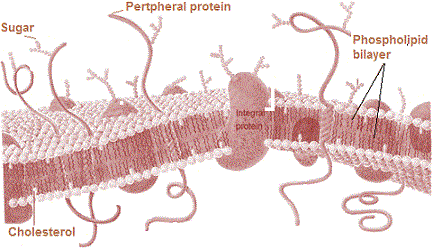The plasma membrane
After the advent of the electron microscope, detailed structure of the membrane was studied in the 1950s. Meanwhile, chemical studies on the cell membrane, especially in human red blood cells (RBCs), enabled the scientists to deduce the possible structure of plasma membrane.
These studies showed that the cell membrane is mainly composed of lipids and proteins. The major lipids are phospholipids that are arranged in a bilayer, lipids are arranged within the membrane with the polar head towards the outer sides and the hydrophobic tails towards the inner part.This ensures that the nonpolar tail of saturated hydrocarbons is protected from the aqueous environment. In addition to phospholipids membrane also contains cholesterol.
Later biochemical investigation clearly revealed that the cell membranes also possess protein and carbohydrate. The ratio of protein and lipid varies considerably in different cell types.
In human beings, the membrane of the erythrocyte has approximately 52% protein and 40% lipids. Depending on the ease of extraction, membrane proteins can be classified as integral and peripheral.
Peripheral proteins lie on the surface of membrane .
Integral proteins are partially or totally buried in the membrane.

In 1972, Singer and Nicolson proposed an improved model for structure of cell membrane which was widely accepted as fluid mosaic model.
According to this, the quasi-fluid nature of lipid enables lateral movement of proteins within the overall bilayer. This ability to move within the membrane is measured as its fluidity.
Functions of the plasma membrane
The fluid nature of the membrane is important in functions like cell growth, formation of intercellular junctions, secretion, endocytosis, cell division etc.
One of the most important functions of the plasma membrane is the transport of the molecules across it. The membrane is selectively permeable to some molecules present on either side of it. Many molecules can move briefly across the membrane without any requirement of energy and this is called the passive transport.
Neutral solutes may move across the membrane by the process of simple diffusion along the concentration gradient (from higher concentration to the lower).
Water may also move across this membrane from higher to lower concentration. Movement of water by diffusion is called osmosis.
As the polar molecules cannot pass through the nonpolar lipid bilayer they require a carrier protein of the membrane to facilitate their transport across the membrane.
A few ions or molecules are transported across the membrane against their concentration gradient (from lower to the higher concentration). Such a transport is an energy dependent process, in which ATP is utilised and is called active transport ( Na+/K+ Pump).
The Components of plasma membrane
| Component | Location |
|---|---|
| Phospholipids | Main fabric of the membrane |
| Cholesterol | Tucked between the hydrophobic tails of the membrane phospholipids |
| Integral proteins | Embedded in the phospholipid bilayer, may or may not extend through both layers |
| Peripheral proteins | On the inner or outer surface of the phospholipid bilayer, but not embedded in its hydrophobic core |
| Carbohydrates | Attached to proteins or lipids on the extracellular side of the membrane (forming glycoproteins and glycolipids) |
